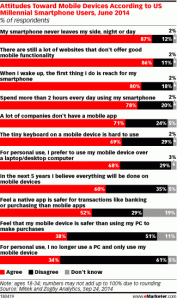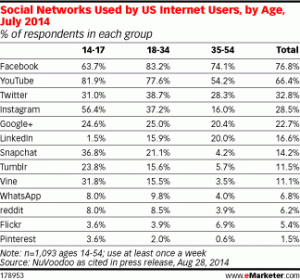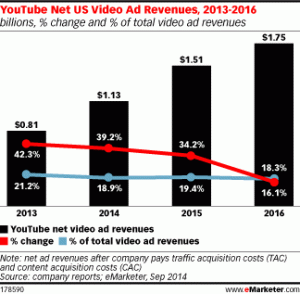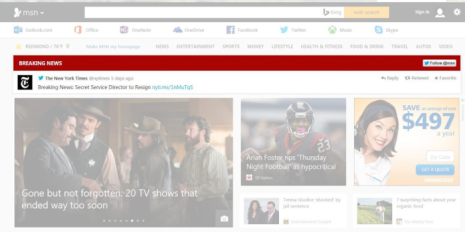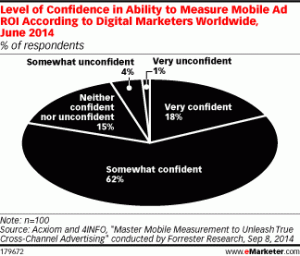John Herrman nailed it with his analysis of Web content catering to the traffic masses. And I’m a few days late on Andrew Sullivan’s interview, but he has some powerful words for the likes of BuzzFeed and New York Times. Also, NewsWhip’s latest Twitter publisher rankings.
Snapchat CEO Spiegel Says Untargeted Advertising Is Coming Soon (Wall Street Journal)
Evan Spiegel, the startup’s 24-year-old co-founder and chief executive, said Wednesday at a conference that the company will “soon” debut its first ads. The messages will appear within the Snapchat Stories feature, in between the photos and videos shared by users, and will not be targeted to individual users based on their tastes, he said.
The ads will be the first source of revenue for three-year-old Snapchat, a company recently valued at $10 billion by investors.
Several brands, including Taco Bell and food delivery service Grubhub, already use Snapchat to offer promotions and hold contests with their most loyal users.
AOL’s new video head: We’re doubling down (Digiday)
To do so, the company has tapped Dermot McCormack, who previously led Viacom’s connected content group for brands like MTV and VH1, as its new president of video and studios.
“We’re going to try to be a next-generation connected content company. … Social media is an important piece. I really believe the right application of a technology can make a good story great.”
“We have to think about different ways of marketing and making shows. … We won’t win by creating the same type of content as everybody else.”
“In terms of the focus of the company, it is the No. 1 priority: to grow the video advertising business. It’s a huge area of focus.”
“I want to meet the team and get to know everybody. Hopefully James Franco is around. He’s in lots of shows.”
Marketwatch editor: Most stories will now be less than 400 words (Talking Biz News)
The majority of our stories will soon be under 400 words — breaking everything down into short bursts of news and insight that cut straight to what is most important to readers, without all the empty calories and filler journalists love to stuff in the sausage . We will also do longer, deep dives on important stories that warrant such treatment. This is the way the digital news is going: tall and venti, no more grande.
I am looking for reporters who can find the bagel in every story. Tweets are now the atomic unit of journalism. When quizzing reporters on their stories, editors used to say, “So what’s the headline here?” Now we ask, “what’s the tweet?”
Cash and Anxiety on the Weird New Internet (The Awl)
What can Publishers Learn From This? A literal interpretation: SUBLIMATE YOUR IDENTITY ENTIRELY, EVERY MONTH, because nothing else works, and the next PlayBuzz of Viral Nova could appear tomorrow and just totally house you out of nowhere.
Again, this isn’t about changing subjects, but changing containers: Upworthy has been posting similar types of videos for the last two years but its headline templates—or rather, headlines that have tested well—have shifted noticeably.
It’s hard to believe that this is just refinement. One possible explanation: Novel formats fall as quickly as they rise, especially if they contain little of value. Or if they’re just new ways to cry wolf.
For the last few weeks, Alex Balk’s five-year-old “How To Cook A Fucking Steak” post has been hovering near the top of our live stats. We have a few posts that surge like that from time to time, and Steak is one of them, but this is different: Facebook seems to have… found it. Yesterday we had a handful of stories that were doing “well” by our standards, but that were all less popular than Steak. We don’t know WHERE on Facebook Steak resurfaced, or why—some horrible Thug Kitchen effect?—but it just keeps on going. To be clear: We are glad that more people are interested in learning How To Cook a Fucking Steak. But this will end at some point which we cannot predict and, in retrospect, will not be able to explain. And then it will happen again. Drink!
The Biggest Twitter Publishers of September 2014 (NewsWhip)
-BBC and the New York Times continue to dominate the top of the chart.
-Mashable re-take third place, over ABC News.
-The BBC’s Scottish Independence Referendum results coverage was the month’s most-tweeted story.
-Entrepreneur.com and TMZ join the top 25.
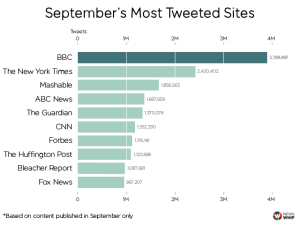
How PlayBuzz Went Viral (NewsWhip)
With even a grammar test scoring close to 2m interactions, it’s impossible to leave PlayBuzz out of the viral equation, especially given that they’re now ranked as a top 10 US mobile site. Their rise has been faster, more sustained and more dramatic than other viral names such as Upworthy and Viral Nova.
“PlayBuzz is a content platform designed to allow everyone, from bloggers to major publishers to just any person, to create content that has the potential to become viral and shareable…Content is generated by more than 5,000 major websites, blogs and brands, and then embedded on their sites and apps.”
“That’s why the title and thumbnail of an item are crucial – that’s what most users will be clicking on their feed, not on the post we made on the PlayBuzz Facebook page.”
“Our goal is to always offer new playful content formats that publishers can utilize in order to drive users’ interest and engagement in new ways.”
Vice News teams up with Skype (MediaWeek)
Vice News plans to use Skype’s voice and video technology to enable audience participation and to expand news coverage around the world.
Among possible new formats are roundtable debates with Vice News selecting a topical issue and inviting representatives with differing views to participate. Another possibility under consideration is for Vice News reporters to take questions live on air from around the world.
Haters gonna hate: A guide to the backlash against Vice (Digiday)
Questions about Vice’s millennial reach also touch on the site’s limited reach overall. While Vice claims that it has 150 million unique visitors a month, its comScore numbers give it a much smaller reach of just 9.3 million people. The story is the same on YouTube, where Vice and Vice News have 5 million and 977,908 subscribers, respectively.
The problem? That’s YouTube’s audience, not Vice’s.
“They don’t even own their own voice because all of their scale is on other people’s platforms,” said one media executive. “How can they be worth that much and only have less than 10 million monthly UVs?”
Social Logins May Actually Be a Thing (eMarketer)
According to July 2014 research by OnePoll for Gigya, 77% of US internet users ages 18 to 55 had signed in to sites or apps via social login, up from 45% in 2012.
Respondents were most likely to access a website or app with a social network ID in order to avoid filling out new registration forms—in other words, save a few minutes. Not wanting to create and remember another username and password was also a top reason for logging in with a social ID, cited by 47%.
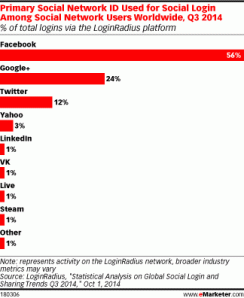
The Weather Channel’s Secret: Less Weather, More Clickbait (BW)
Neil Katz, weather.com’s editor-in-chief, listens to their ideas and selects the ones he thinks readers will like. Bald and bookish, he speaks quietly but clearly, just like everyone else he works with. He approves the skylines and castles, says “maybe” to the weight loss, and gives enthusiastic approval to a story about a scientist who works in an active volcano, because volcanoes are cool.
Katz calls these types of stories “weather adjacent,” and during the last two years he’s peppered weather.com with thousands of them. He’s changed the way the Weather Channel’s website presents the weather, doubling the site’s traffic even as viewers drift away from the TV network. People come to his website or mobile app looking for the local forecast; it’s Katz’s job to keep them there with headlines such as “12 Spooky Abandoned Hospitals and Asylums” and “What Does Mars Smell Like?”
Sure, only a couple hundred thousand people watch the Weather Channel on any one day, but about 7 million visit weather.com and an additional 13 million look at its app. “This week we did 25,000 forecasts per second—that’s 2 billion in a day,” Kenny says.
Under Katz, the nonforecast part of the website has more than doubled its page views, from 1 billion in 2012—already an anomalous number because of Hurricane Sandy traffic spikes—to 2.4 billion this year, despite the frustratingly calm weather. More than 150 million people have downloaded its app.
Following its expansion, the Weather Channel can collect data about people, not just weather. Last year it launched WeatherFX, an in-house advertising agency that combs through mounds of weather data, matching it to consumers, and sells its discoveries to its advertisers.
The company persuaded advertisers such as Wal-Mart Stores (WMT) and Procter & Gamble (PG) to hand over their sales data for every product they sold, in every store, in every aisle, all over the country. “I mean that literally,” says Vikram Somaya, general manager of WeatherFX. “We said, ‘Give us your data.’ Traditionally, that’s not been met with a whole lot of resounding cheer, right?” But the stores did it. WeatherFX’s team then matched the information with the past 30 years of local weather data and uncovered sales trends so specific they surprised even the data scientists.
…WeatherFX has formed partnerships with more than 200 brands. It figured out how to sell cold and flu medicine in the middle of the summer. It helped Michaels Stores (MIK) promote rainy-day craft supplies by offering coupons and reminding parents a few days in advance. It even figured out that when Seattle has several days of rain followed by four hours of sunshine, “everybody goes crazy,” as Somaya puts it, and rushes to eat a fruit cup—again, it’s that specific—outside.
The only reason any of this works is because the Weather Channel app constantly tracks users’ locations—it has to, otherwise it can’t provide a forecast. And WeatherFX plans to tailor ads not only to a forecast but to an exact location. In Chicago on a warm (OK, less frigid), sunny winter day? You probably want to eat yogurt. And oh, look at that—you’re driving right by a Trader Joe’s, which happens to be having a sale.
A native variety: 7 very different approaches to the tricky business of native advertising (The Media Briefing)
1. Daily Mail 2. Forbes 3. BuzzFeed 4. Quartz 5. New York Times 6. Guardian Labs 7. Washington Post
The 60-second interview: Andrew Sullivan, founding editor, The Dish (Capital)
We currently have 30,200 paying auto-renewing subscribers. Our monthly traffic is between 700,000 to a million uniques, our subscription renewal rate is 83 percent. We also have a pay-what-you want model above a certain baseline. The average subscription when we launched was $34; this year it went up to $39, but with fewer subscribers.
I think the only future for journalism is reader revenue. Without it, you are in danger of becoming a public relations or advertising company disguised as journalism, like Buzzfeed and even The Guardian. Buzzfeed is really an ad agency with some journalistic window dressing. They’re not the future of journalism; they’re the marginalization of it. And The New York Times, alas, is following suit with merry abandon.
Is Instagram Becoming a TV Substitute Like YouTube? (AdWeek)
Consumers Bullish on a Mobile Payments Future (eMarketer)
Consumers remain tepid about paying for goods and services with their phones at the point of sale, although increased exposure to mobile payments is helping drive adoption and growth…
Even in a persistently fragmented market, US proximity payment transaction values doubled between 2012 and 2013 to reach $1.59 billion as more consumers warmed to paying for their daily cup of coffee with their phones. eMarketer projects transaction values will double again this year to reach $3.50 billion and further accelerate through 2016 as more users come on board and make increasingly larger mobile purchases.
Should publishers take down controversial posts? (Digiday)
